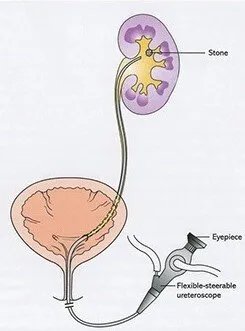RIRS (Retrograde Intrarenal Surgery) is a minimally invasive procedure used to treat kidney stones that are located within the kidney or upper ureter. One of the common concerns for individuals considering RIRS is whether the procedure is painful.
Here’s a detailed look at what RIRS entails and the associated pain management:
Understanding RIRS Procedure
- Minimally Invasive Approach: RIRS is performed using a thin, flexible scope (ureteroscope) that is passed through the urinary tract into the kidney. This scope allows the urologist to visualize the stone and use small instruments to break it into smaller pieces for removal.
- Anesthesia: RIRS is typically performed under general anesthesia or sometimes under spinal anesthesia. This means that during the procedure, you will be unconscious (general anesthesia) or numb from the waist down (spinal anesthesia), and therefore, you won’t experience any pain or discomfort during the surgery itself.
- Post-Procedure: After RIRS, some patients may experience mild discomfort or pain. This is usually managed effectively with pain medications prescribed by the urologist. The discomfort is often described as manageable and comparable to mild to moderate menstrual cramps or minor irritation in the bladder area.
Pain Management After RIRS
- Medications: Your healthcare team will provide pain medications to help manage any discomfort after the procedure. These medications may include over-the-counter pain relievers or stronger prescription medications depending on your individual needs.
- Fluid Intake: Drinking plenty of water and staying well-hydrated can also help minimize discomfort and aid in flushing out any remaining stone fragments after RIRS.
- Follow-Up Care: It’s important to follow all post-operative instructions provided by your urologist, which may include avoiding strenuous activities for a few days and taking medications as prescribed to prevent infection and manage pain.
Expected Recovery
Recovery from RIRS is generally quick, with many patients able to resume normal activities within a few days to a week after the procedure. The level of discomfort or pain experienced can vary depending on factors such as the size and location of the kidney stone, as well as individual pain tolerance.
Conclusion
While the idea of undergoing any surgical procedure can be daunting, RIRS is considered minimally invasive and generally well-tolerated by patients. With advancements in anesthesia and pain management techniques, discomfort during and after RIRS is kept to a minimum, allowing patients to undergo treatment for kidney stones with confidence in their comfort and recovery. If you have concerns about pain or discomfort related to RIRS, discussing them openly with your urologist can provide reassurance and ensure that you receive appropriate care and support throughout the process.






Comments